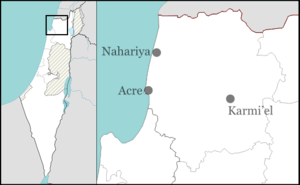Shtula
Shtula (Hebrew: שְׁתוּלָה, lit. Planted) is a moshav in northern Israel. Located in the Upper Galilee near the Lebanese border, it falls under the jurisdiction of Ma'ale Yosef Regional Council. In 2018 it had a population of 283.[1]
Shtula שְׁתוּלָה | |
|---|---|
 Shtula  Shtula | |
| Coordinates: 33°5′7.94″N 35°18′47.37″E | |
| Country | |
| District | Northern |
| Council | Ma'ale Yosef |
| Affiliation | Moshavim Movement |
| Founded | 1967 |
| Founded by | Galilee moshavniks |
| Population (2018)[1] | 283 |
| Name meaning | "Planted" |
| Website | www.shtula.org.il |
History
The moshav was established in 1967 by moshav residents from the Galilee as part of Operation Sof Sof, designed to strengthen Jewish presence in the Galilee. Its name is symbolic and has a similar meaning to that of nearby Netu'a.
The moshav is located on the land of the Palestinian villages of Suruh and Tarbikha, which were depopulated in the 1948 Arab–Israeli War.[2]
The village was the site of Hezbollah's cross-border raid in the 2006 Lebanon War, in which three Israeli soldiers were killed and two captured.
gollark: I don't think that would work:- people would *obviously* try and represent themselves as cooperative when they aren't- just having 150 representatives a level probably won't help because you are not communicating with these people outside of... representative duties
gollark: That means you still need to work out resource allocation/conflict resolution for the larger-scale things.
gollark: Anyway. People can probably work together in self-organizing small groups using social mechanisms, sure. *But* you're limited to Dunbar's number - about 150 people - and larger scale coordination than that is necessary.
gollark: I don't really know our family income so I can't compare that against the countrywide distribution.
gollark: Eh, upper middle maybe.
References
- "Population in the Localities 2018" (XLS). Israel Central Bureau of Statistics. 25 August 2019. Retrieved 26 August 2019.
- Khalidi, W. (1992). All That Remains: The Palestinian Villages Occupied and Depopulated by Israel in 1948. Washington D.C.: Institute for Palestine Studies. pp. 32, 34. ISBN 0-88728-224-5.
This article is issued from Wikipedia. The text is licensed under Creative Commons - Attribution - Sharealike. Additional terms may apply for the media files.